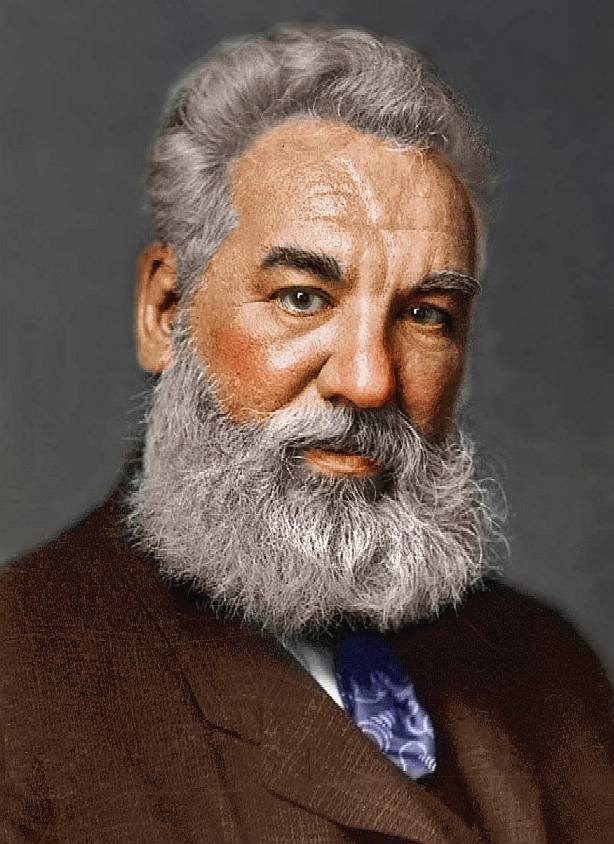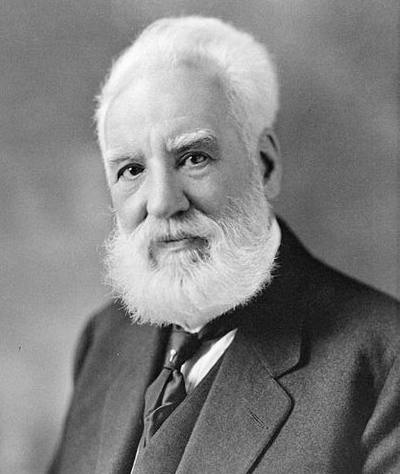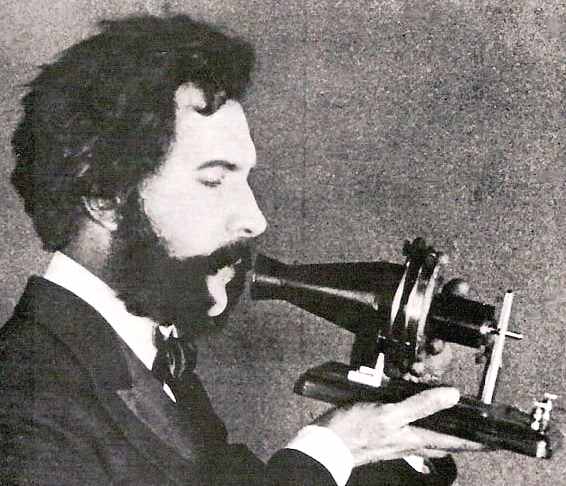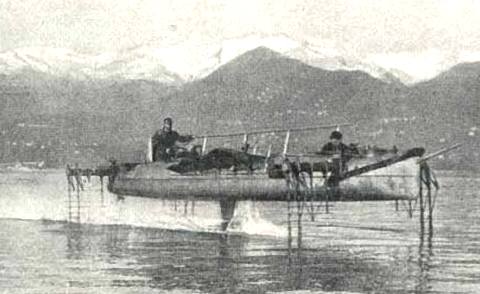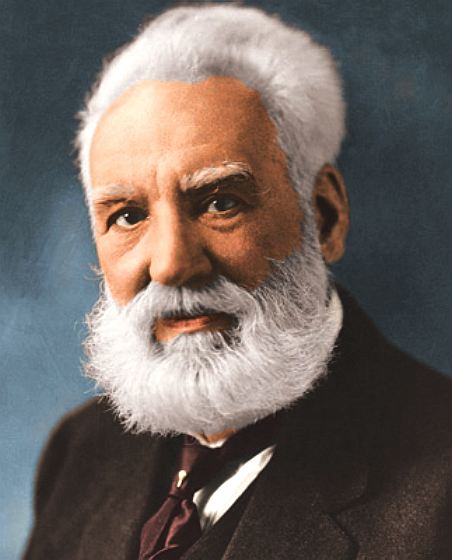|
ALEXANDER GRAHAM BELL
|
|||||
|
Alexander Graham Bell (March 3, 1847 – August 2, 1922) was a Scottish-born scientist and inventor. Today, Bell is still widely considered to be the foremost inventor of the telephone, although this matter has become controversial, with a number of people claiming that Antonio Meucci was the 'real' inventor (in June 2002, the United States House of Representatives passed a symbolic bill officially recognizing Meucci for his contributions to the invention of the telephone). Others advance Elisha Gray, the founder of the Western Electric Manufacturing Company. (It is reasonably clear that each of these men independently invented a telephone.) In addition to Bell's work in telecommunications technology, he was responsible for important advances in aviation and hydrofoil technology.
Alexander Graham Bell
Biography
Born Alexander Bell in Edinburgh on March 3, 1847, he later adopted the middle name Graham out of admiration for Alexander Graham, a family friend. Many called Bell "the father of the Deaf." This title may be regarded as somewhat ironic due to his belief in the practice of eugenics. He hoped to one day eliminate hereditary deafness from the population.
His family was associated with the teaching of elocution: his grandfather in London, his uncle in Dublin, and his father, Alexander Melville Bell, in Edinburgh, were all professed elocutionists. The latter has published a variety of works on the subject, several of which are well known, especially his treatise on Visible Speech, which appeared in Edinburgh in 1868. In this he explains his method of instructing deaf mutes, by means of their eyesight, how to articulate words, and also how to read what other persons are saying by the motions of their lips.
Alexander Graham Bell was educated at the Royal High School of Edinburgh, from which he graduated at the age of 13. At the age of 16 he secured a position as a pupil-teacher of elocution and music in Weston House Academy, at Elgin, Moray, Scotland. The next year he spent at the University of Edinburgh. He was graduated from University College London.
From 1866 to 1867, he was an instructor at Somersetshire College at Bath, Somerset, England.
While still in Scotland he is said to have turned his attention to the science of acoustics, with a view to ameliorate the deafness of his mother.
In 1870, at the age of 23, he emigrated with his family to Canada where they settled at Brantford. Before he left Scotland, Bell had turned his attention to telephony, and in Canada he continued an interest in communication machines. He designed a piano which could transmit its music to a distance by means of electricity. In 1873, he accompanied his father to Montreal, Canada, where he was employed in teaching the system of visible speech. The elder Bell was invited to introduce the system into a large day-school for mutes at Boston, but he declined the post in favor of his son, who became Professor of Vocal Physiology and Elocution at Boston University's School of Oratory.
At Boston University he continued his research in the same field, and endeavored to produce a telephone which would not only send musical notes, but articulate speech. With financing from his American father-in-law, on March 7, 1876, the U.S. Patent Office granted him Patent Number 174,465 covering the telephone:-
After obtaining the patent for the telephone, Bell continued his many experiments in communication, which culminated in the invention of the photophone-transmission of sound on a beam of light — a precursor of today's optical fiber systems. He also worked in medical research and invented techniques for teaching speech to the deaf. The range of Bell's inventive genius is represented only in part by the eighteen patents granted in his name alone and the twelve he shared with his collaborators. These included fourteen for the telephone and telegraph, four for the photophone, one for the phonograph, five for aerial vehicles, four for hydroairplanes, and two for a selenium cell.
Bell had many great ideas that are now real inventions. During his Volta Laboratory period, Bell and his associates considered impressing a magnetic field on a record, as a means of reproducing sound. Although the trio briefly experimented with the concept, they were unable to develop a workable prototype. They abandoned the idea, never realizing they had glimpsed a basic principle which would one day find its application in the tape recorder, the hard disc and floppy disc drive, and other magnetic media.
Bell's own home used a primitive form of air conditioning, in which fans blew currents of air across great blocks of ice. He also anticipated modern concerns with fuel shortages and industrial pollution. Methane gas, he reasoned, could be produced from the waste of farms and factories. At his Canadian estate in Beinn Bhreagh, Nova Scotia, he experimented with composting toilets and devices to capture water from the atmosphere. In a magazine interview published shortly before his death, he reflected on the possibility of using solar panels to heat houses.
In 1882, he became a naturalized citizen of the United States. In 1888, he was one of the founding members of the National Geographic Society and became its second president. He was the recipient of many honors. The French Government conferred on him the decoration of the Légion d'honneur (Legion of Honor), the Académie française bestowed on him the Volta Prize of 50,000 francs, the Royal Society of Arts in London awarded him the Albert Medal in 1902, and the University of Würzburg, Bavaria, granted him a Ph.D. He was awarded the AIEE's Edison Medal in 1914 for "For meritorious achievement in the invention of the telephone."
Bell married Mabel Hubbard, who was one of his pupils at Boston University, as well as a deaf-mute, on July 11, 1877. His invention of the telephone was actually a device he was trying to create that would allow him to communicate with his wife and his deaf mother. He died at Beinn Bhreagh, located on Nova Scotia's Cape Breton Island near the village of Baddeck, in 1922 was buried atop Beinn Bhreagh mountain overlooking Bras d'Or Lake. He was survived by his wife and two of their four children.
Bell was listed among the 100 Greatest Britons, the 100 Greatest Americans and in the top ten Greatest Canadians, the only person to be on more than one list.
Bell speaking into prototype telephone
Bell and decibel
The bel (B) is a unit of measurement originally proposed by 1929 W. H. Martin of Bell Labs (Bell System Techn. Jrnl. VIII. 2) and named after Bell. The bel was too large for everyday use, so the decibel (dB), equal to 0.1 B, became more commonly used.
The dB is commonly used as a unit for expressing sound pressure level and sound power. Since the decibel is a ratio it must be related to a reference value, commonly 20 µPa for sound pressure level and 10-12 watts for sound power level. Decibels are also be used to express electrical ratios such as power.
The photophone
Another of Bell's inventions was the photophone, a device enabling the transmission of sound over a beam of light, which he developed together with Charles Sumner Tainter. The device employed light-sensitive cells of crystalline selenium, which has the property that its electrical resistance varies inversely with the illumination (i.e., the resistance is higher when the material is in the dark, and lower when it is lighted). The basic principle was to modulate a beam of light directed at a receiver made of crystalline selenium, to which a telephone was attached. The modulation was done either by means of a vibrating mirror, or a rotating disk periodically obscuring the light beam.
This idea was by no means new. Selenium had been discovered by Jöns Jakob Berzelius in 1817, and the peculiar properties of crystalline or granulate selenium were discovered by Willoughby Smith in 1873. In 1878, one writer with the initials J.F.W. from Kew described such an arrangement in Nature in a column appearing on June 13, asking the readers whether any experiments in that direction had already been done. In his paper on the photophone, Bell credited one A. C. Browne of London with the independent discovery in 1878—the same year Bell became aware of the idea. Bell and Tainter, however, were apparently the first to perform a successful experiment, by no means any easy task, as they even had to produce the selenium cells with the desired resistance characteristics themselves.
In one experiment in Washington, D.C. the sender and the receiver were placed on different buildings some 700 feet (213 metres) apart. The sender consisted of a mirror directing sunlight onto the mouthpiece, where the light beam was modulated by a vibrating mirror, focused by a lens and directed at the receiver, which was simply a parabolic reflector with the selenium cells in the focus and the telephone attached. With this setup, Bell and Tainter succeeded to communicate clearly.
The photophone was patented on December 18, 1880, but the quality of communication remained poor and the research was not pursued by Bell.
Metal detector
Bell is also credited with the invention of the metal detector in 1881. The device was hurriedly put together in an attempt to find the bullet in the body of U.S. President James Garfield. The metal detector worked, but didn't find the bullet because the metal bedframe the President was lying on confused the instrument. Bell gave a full account of his experiments in a paper read before the American Association for the Advancement of Science in August 1882. Though unsuccessful in its first incarnation, this achievement would eventually change the nature of physical security.
Hydrofoil boat 1910 Forlanini Idroplano - Lake Maggiore
The hydrofoil
The March 1906 Scientific American article by American hydrofoil pioneer William E. Meacham explained the basic principle of hydrofoils. Bell considered the invention of the hydroplane as a very significant achievement. Based on information gained from that article he began to sketch concepts of what is now called a hydrofoil boat.
Bell and Casey Baldwin began hydrofoil experimentation in the summer of 1908 as a possible aid to airplane takeoff from water. Baldwin studied the work of the Italian inventor Enrico Forlanini and began testing models. This led him and Bell to the development of practical hydrofoil watercraft.
During his world tour of 1910–1911 Bell and Baldwin met with Forlanini in Italy. They had rides in the Forlanini hydrofoil boat over Lake Maggiore. Baldwin described it as being as smooth as flying. On returning to Baddeck a number of designs were tried culminating in the HD-4, using Renault engines. A top speed of 54 miles per hour was achieved, with rapid acceleration, good stability and steering, and the ability to take waves without difficulty. Bell's report to the navy permitted him to obtain two 350 horsepower (260 kW) engines in July 1919. On September 9, 1919 the HD-4 set a world's marine speed record of 70.86 miles per hour. This record stood for ten years.
Bell was a supporter of aerospace engineering research through the Aerial Experiment Association, officially formed at Baddeck, Nova Scotia in October 1907 at the suggestion of Mrs. Mabel Bell and with her financial support. It was headed by the inventor himself. The founding members were four young men, American Glenn H. Curtiss, a motorcycle manufacturer who would later be awarded the Scientific American Trophy for the first official one-kilometre flight in the Western hemisphere and later be world-renowned as an airplane manufacturer; Frederick W. "Casey" Baldwin, the first Canadian and first British subject to pilot a public flight in Hammondsport, New York; J.A.D. McCurdy; and Lieutenant Thomas Selfridge, an official observer from the U.S. government. One of the project's inventions, the aileron, is a standard component of aircraft today. (The aileron was also invented independently by Robert Esnault-Pelterie.)
Eugenics
Along with many very prominent thinkers and scientists of the time, Bell was connected with the eugenics movement in the United States. From 1912 until 1918 he was the chairman of the board of scientific advisors to the Eugenics Record Office associated with Cold Spring Harbor Laboratory in New York, and regularly attended meetings. In 1921 he was the honorary president of the Second International Congress of Eugenics held under the auspices of the American Museum of Natural History in New York. Organizations such as these advocated passing laws (with success in some states) that established the compulsory sterilization of people deemed to be, as Bell called them, a "defective variety of the human race." By the late 1930s about half the states in the US had eugenics laws, the California laws being used as a model for eugenics laws in Nazi Germany.
Much of his thoughts about people he considered defective centered on the deaf because of his long contact with them in relation to his work in deaf education. In addition to advocating sterilization of the deaf, Bell wished to prohibit deaf teachers from being allowed to teach in schools for the deaf, he worked to outlaw the marriage of deaf individuals to one another, and he was an ardent supporter of oralism over manualism. His avowed goal was to eradicate the language and culture of the deaf so as to force them to integrate into the hearing culture for their own long-term benefit and for the benefit of society at large. Although this attitude is widely seen as paternalistic and arrogant today, it was mainstream in that era.
Although he supported what many would consider harsh and inhumane policies today, he was not unkind to deaf individuals who proved his theories of oralism. He was a personal and longtime friend of Helen Keller, and his wife Mabel was deaf, though none of their children were. Bell was well known as a kindly father and loving family man who took great pleasure in playing with his many grandchildren.
His son-in-law was National Geographic Editor Gilbert Hovey Grosvenor.
Tribute
In the early 1970s, UK Rock Group The Sweet recorded a tribute to Bell and the telephone, suitably titled "Alexander Graham Bell". The song gives a fictional account of the invention, in which Bell devises the telephone so he can talk to his girlfriend who lives on the other side of the United States. The song reached the top 40 in the UK and went on to sell over one million recordings world-wide.
Another musical tribute to Bell was written by the British songwriter and guitarist Richard Thompson. The chorus of Thompson's song reminds the listener that "of course there was the telephone, he'd be famous for that alone, but there's fifty other things as well from Alexander Graham Bell". The song mentions Bell's work with discs rather than cylinders, the hydrofoil, Bell's work with the deaf, his invention of the respirator and several other of Bell's achievements.
LINKS:
FIND YOUR PERFECT PHONE A - Z
No matter what style, design or features you need on your phone, it pays to shop for a good deal ...................
Finding the right mobile phone and airtime package from numerous high street and online dealers can prove to be an overwhelming challenge. However, there’s more to a search than just finding a good looking phone. You need to ensure you get a reliable service and sensibly priced airtime. We therefore recommend you see these Mobile Phone Dealers before buying.
INVENTORS A - Z
The ultimate Robot Boat. Solarnavigator uses an advanced SWASSH hull as the platform to mount the world's first autonomous circumnavigation. A successful expedition could pave the way for improved safety at sea.
|
|||||
|
This website is copyright © 1991- 2013 Electrick Publications. All rights reserved. The bird logo and names Solar Navigator and Blueplanet Ecostar are trademarks ™. The Blueplanet vehicle configuration is registered ®. All other trademarks hereby acknowledged and please note that this project should not be confused with the Australian: 'World Solar Challenge'™which is a superb road vehicle endurance race from Darwin to Adelaide. Max Energy Limited is an educational charity working hard to promote world peace.
|
|||||
|
AUTOMOTIVE | BLUEPLANET BE3 | ELECTRIC CARS | ELECTRIC CYCLES | SOLAR CARS | SOLARNAVIGATOR |
